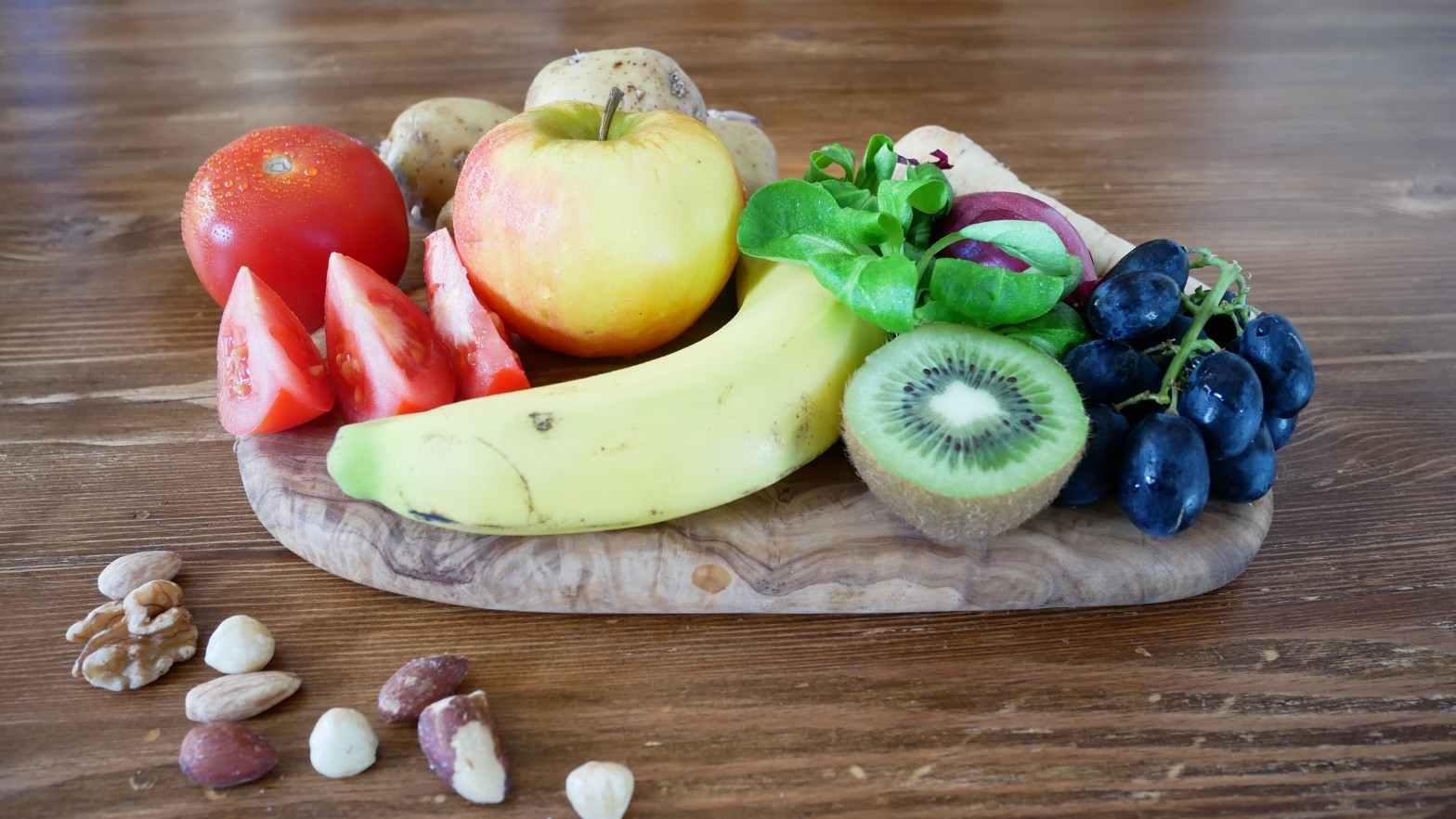We all need it to stay fit and healthy: a balanced diet. But not everyone likes to eat fruit and vegetables, therefore ready-made smoothies or vitamin supplements may be very tempting alternatives. But are these products good alternatives to fresh produce, or maybe even harmful? What do we need the nutrients for and how much of it can the body absorb? Knowing the answers to these questions can help us to make the best choices for our diet and thus our health.
Why do we need vitamins and minerals?
Vitamins and minerals are substances that the body needs for many of its functions but cannot produce on its own. That means that these molecules must be taken in with the food. Luckily, plants and some animals can produce vitamins or their precursors and thus serve as a source for these vital substances. And those are needed to drive biocatalysts in the body, called enzymes. That is why vitamins are also called coenzymes.
In simple terms, enzymes can be thought of as small factories within a living being, in which starting materials are processed into finished products. This way, they are responsible for many processes in the body. Enzymes are, for example, needed to produce amino acids which are important for cell division and muscle building. In order to function ideally, they need the coenzymes: vitamins and minerals. If you think of the enzyme as a factory producing the amino acids, the coenzyme would be the conveyor belt. This is where the chemical changes are made that result in the finished product.
The enzyme is formed by the body itself, thus it is practically always present, but can only work if the coenzyme is available. Furthermore, the chemical reaction changes not only the starting material, but also the coenzyme, making it unable to function. The factory is idle until new vitamins, ingested from food, replace the used ones. That is why it is so important to constantly replenish our body’s factories with new vitamins.
Why does the body produce incomplete enzymes?
In principle, the body’s enzymes are unfinished and require a component from outside, in order to function. Sounds stupid right? Well, it’s not. The body uses energy and raw materials to produce components in the body. Since we constantly ingest the coenzymes anyway, the body can save the energy of producing the molecules itself. Looking at it this way, the body is a little lazy and saves the work. But this also means that it is dependent on a balanced diet.
Where does the idea with the pills come from?
It was not until the beginning of the twentieth century that scientists discovered the importance of vitamins. For the first-time scientists associated nutrient deficiency with various, sometimes fatal symptoms. The lack of vitamin C for instance, leads to scurvy. After researchers gained these insights, it did not take long for commercial benefits to be created. Once vitamin C could be produced synthetically, manufacturers wanted to ensure sales and pursued intensive lobbying. They persuaded doctors to attest people to vitamin C deficiency and prescribe the nutrient in the form of powder or tablets 1, 2, 3.
And that is certainly not the only case where people have been suggested to have a deficiency that can only be compensated for by industrially manufactured products. If you enter symptoms such as fatigue on Google, you will quickly come to pages that want to attribute this to vitamin or mineral deficiency symptoms. They also show in which food the substance is found. However, advertising for corresponding pills often appears as well. Either as a window next to the article or it is sold directly on the page. Mostly with the added note that the dietarily necessary amounts cannot be taken in with the food. But what is behind it, science, or clever marketing?
In any case, many health experts, such as doctors, do not recommend consuming any nutrients in form of tablets anymore, unless there is a proven medical need for it 8, 9, 15. Here are six reasons why vitamin-/ mineral supplements are unnecessary.
- The so-called bioavailability. Minerals in particular can occur in mixtures with other compounds and these substances determine how well by the body can absorb the nutrients. An example of this is silicon. It can occur in so-called inorganic compounds, that is the form in which the molecules exist in the soil. Humans cannot absorb the inorganic compounds very well. Plants, on the other hand, can absorb them much better and convert them into so-called organic silicon compounds. This form of silicon can then be better absorbed by the human organism. But manufacturers of silicon pills often use the inorganic version. Therefore, the amount of silicon measured in the blood is much higher if you drink a non-alcoholic beer than if you consumed silica capsules 4.
- The body can often only absorb parts of the amounts contained in the tablets. For example, the more vitamin C you consume, the lower percentage of it gets into your body. If you increase the intake from 100 mg to 1000 mg, the content in the blood only increases twice, not ten times, as the concentration ingested. The rest is lost as it is unused and resources are wasted this way 5, 6.
- Components of the food help with the absorption. The absorption rate of minerals in the body is increased if the fruit sugar fructose is consumed at the same time. But we also need the support of our gut bacteria. Those help for example, to absorb vitamin D. They also release many substances that we would otherwise not get from our diet. The intestinal bacteria need fiber to survive, and we must ingest them via fruit, vegetables, and whole grain products. Furthermore, fat is required for the absorption of vitamin D. If you take a tablet on an empty stomach, the content will just end up in toilet 7, 8.
- Sometimes nutrients need each other, sometimes they interfere with each other. A multitude of vitamins and minerals is often required to perform the complex processes in our body. That means, if you take vitamin D pills, your body also needs vitamin K for the process of storing minerals in the bones. And of course, you need to consume said minerals as well. A supplementation of vitamin D alone is not enough, if the other nutrients are missing 9. Minerals, on the other hand, tend to interfere with each. Too much calcium can disturb magnesium’s function. Too much zinc can interfere with copper’s function. Amounts that lead to such interactions are generally not reached by food, but by tablets 9.
- Too much can be unhealthy. An overdose leads to negative effects with some vitamins and minerals. For example, high levels of vitamin C can promote the formation of kidney stones and irritate the stomach. Too much vitamin A can lead to symptoms such as dizziness and can have a long-term effect on bone structure. High levels of vitamin B6 can damage the nerves and high doses of minerals may damage the cells 10, 11, 12, 13, 14.
- In most cases it is simply not necessary to supplement. If you eat enough fruit, vegetables, and cereals, you ingest enough nutrients. At the same time, you also provide the body with important fibers and probably reduce your calorie consumption. It also saves resources to eat like this, because the production of tablets requires a lot of energy and sometimes even generates toxic waste. But you should be careful not to eat one-sided. A good tip is to orientate yourself to the colors of the rainbow and consume one food of each color a day. Vitamin D is an exception to this rule, as it cannot be sufficiently available in winter due to the lack of sunshine. It is also contained in the food in too small amounts, so healthy eating is often not enough in this case 15.
Good eating habits are better than tablets and there are many reasons to eat a healthy and balanced diet. If you do so, you rarely need tablets or capsules. I think the reason why supplements are so profitable is because they are the easiest solution. You have a problem, like a cold you want to get rid of fast or you often feel tired, and you want to do something about it. You want to prevent sickness or feel fitter. If you want to have control over the situation, over your body, it is easiest to swallow a tablet instead of spending hours on the possible causes of symptoms, visits to the doctor, and deal with nutrition.
Everyone should make up their own mind about their diet an adequate nutrient intake. Whether you manage to keep the right nutrition in hectic everyday-life, or you want to use pills. However, it would be advisable to always clarify a suspected deficiency with a doctor, before buying supplements. Health professionals can make recommendations tailored to each person: from people with iron deficiency to pregnant women. But knowing that we can keep up with our nutrient requirements with a balanced diet can help us make healthy choices for a healthy life.
Most important references:
1. 1881, N.I. Lunin Über die Bedeutung der anorganischen Salze für die Ernährung des Thieres. In: Zeitschrift für Physiologische Chemie. Bd. 5, 1881, S. 31–39.
2. 1912, C Funk The preparation from yeast and certain foodstuffs of the substance the deficiency of which in diet occasions polyneuritis in birds. The Journal of Physiology. 1912 Aug 2; 45(1-2): pages 75–81.
3. Der Spiegel, Nr. 3 2012, „Vitamin C – vom Ladenhüter zum Milliardengeschäft” Basler Zeitung, 21. August 2009, „Vitamin C- Das goldene Pulver“ Die Zeit, 14. Mai 2009.
4. Sripanyakorn, S., Jugdaohsingh, R., Dissayabutr, W., Anderson, S. H., Thompson, R. P., & Powell, J. J. (2009). The comparative absorption of silicon from different foods and food supplements. British journal of nutrition, 102(6), 825-834.
5. Jacob, R. A., & Sotoudeh, G. (2002). Vitamin C function and status in chronic disease. Nutrition in clinical care, 5(2), 66-74.
6. Padayatty, S. J., Sun, H., Wang, Y., Riordan, H. D., Hewitt, S. M., Katz, A., … & Levine, M. (2004). Vitamin C pharmacokinetics: implications for oral and intravenous use. Annals of internal medicine, 140(7), 533-537.
7. Human Microbiota in Health and Disease, Bryan Tungland, Kapitel 5.
8. The Doctor’s Kitchen Podcast, Episode 15: Eat for Immunity with Dr. Jenna Macciochi.
9. The Doctor’s Kitchen Blog, Micornutrition Part 1 – Vitamins and Minerals, Wednesday, October 7th, 2015.
10. L. K. Thomas, C. Elinder, H. Tiselius, A. Wolk, A. Åkesson: Ascorbic acid supplements and kidney stone incidence among men: A prospective study. In: JAMA Internal Medicine. Band 173, Nr. 5, 2013, S. 386–388, doi:10.1001/jamainternmed.2013.2296
11. Invited review: Mineral absorption mechanisms, mineral interactions that affect acid–base and antioxidant status, and diet considerations to improve mineral status. Jesse P. Goff 2018.
12. COMMITTEE ON TOXICITY OF CHEMICALS IN FOOD, CONSUMER PRODUCTS AND THE ENVIRONMENT: STATEMENT ON VITAMIN B6 (PYRIDOXINE) TOXICITY. Hrsg.: Department of Health. Juni 1997.
13. Walker, A., Zimmerman, M. R., & Leakey, R. E. (1982). A possible case of hypervitaminosis A in Homo erectus. Nature, 296(5854), 248.
14.https://www.deutsche-apotheker-zeitung.de/news/artikel/2012/ 01/15/die-vitaminluege
15. Homepage of British National Health Service: https://www.nhs.uk/conditions/vitamins-and-minerals/others/


